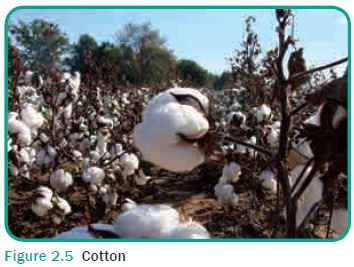Natural Fibres | Textiles - Cotton Fibres | 11th Textiles and Dress Designing : Chapter 2 : Natural Fibres
Chapter: 11th Textiles and Dress Designing : Chapter 2 : Natural Fibres
Cotton Fibres
COTTON
Introduction
Most of the people wear cotton fabric. People
like cotton fabrics more than any other fabric. Cotton (Figure 2.5) was being
used even before 3000 BC. Cotton fabrics are both soft and strong. Cotton is
most popular and widely used fabric. Heavy weight cotton fabrics are even used
as roofing of houses, making footwear and bags.

Growth and Production
Different types of cotton fibres can be produced
from the same cultivation area. It takes 200 – 220 days for the cotton plant to
grow fully. Sunlight and humidity are needed for the growth of cotton. Some
varieties of cotton need 3-5 millimeter of rain for its growth. The quality of
cotton depends upon the soil type, atmospheric condition and fertilizers used.
In South India, cotton is sown during the month of September and October
whereas during the same period it is harvested in North India. Therefore, India
cultivates cotton throughout the year.
Cotton Cultivation and Harvesting
Soil
For cultivation of cotton clay, sand and red sand
are highly adapted.
Climate
The climatic condition needed for the growth of
cotton is warmth and moisture content in air. There should be continu-ous rain
during sowing of cotton; this will help for the fast growth of the plant. Apart
from this a good sunlight, moderate warm temperature is also needed throughout
the growth period.
The Time of Sowing
It can be sown from April to August. The duration
for full growth is 120-180 days.
The Method of Sowing
At first, the land is ploughed well, so that the
air moves freely within the soil. The seed is sown between 1- 15 meter gaps
each. The seeds will start germina-tion within 10-14 days. Later, the growth
will be much quicker. The strong plants are selected and replanted with equal
space. The flowers start appearing within 2-3 months. Later, the fruit starts
to grow with a green colour seed. The cotton seeds will be present inside the
fruit. In these seeds the cotton fibres will start growing from outside. Later,
the fully grown cot-ton fruit (Figure 2.6) will blast and the cotton fibres
will come out.

Harvesting
The cotton fibre should be collected at once;
otherwise the cotton fibre with seed will be carried away by wind. Dust
particles will also spread over cotton fibre, resulting in colour change of the
fibres. Harvesting can be done by hand or by using machines. Next, the
harvested cotton fibres are sent to ginning mills (Figure 2.7).

Ginning
The harvested seeds are dried using warm air, and
stored for ginning. Ginning is the process of separation of fibres from seeds.
Later using special machines the fibres are separated from the seeds. The
sepa-rated fibres are called lint, which have a staple length of 15 to 50 mm.
The very short fibres are called linters. Hundred kilogram of clean cotton
seeds yield 35 kg
Characteristics of Cotton
Luster : Low
Tenacity / Strength : Medium
Elastic Recovery : Low
Elongation : 7%
Resiliency : Low
Density : 1.54 g / cm3
Moisture Absorption : 8.5%
Dimensional Stability : Good
Reaction with Acid : Weakens fibres
Reaction with Alkalies : Resistant (Mercerization)
Effect of Sunlight : Weakens fibres slowly
Insects : Silverfish damages the fibre
Reaction to Flame : Burns readily
Shape : Straw like Structure
Width : 12 – 29 mm
Length : 1.25 – 6 cm
Colour : White, Cream White
Drying : Quick and Good
Dyeing : Good Absorption
Common Uses of Cotton
·
Clothing (Frocks, Socks, Towels, Saree, Dress
Materials).
·
Household Textiles (Bed Spread, Pillows).
· Medical Textiles (Absorbance Pads, Bandages).
Related Topics